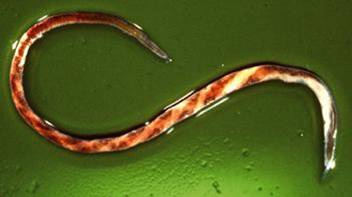
That's what this is all about, right? Well, after spending the weekend in the vineyard training new trunks on most of the Cynthiana vines, I'm finally coming to grips with how cold it got this past winter. We had temperatures in January down close to -20F. Greg has a couple of temperature probes up in the vineyard, one on the top of the hill and one down by the creek, where you would expect cold air to accumulate. He built a spreadsheet to keep track of the temperatures over the winter, and those probes plug right into a USB port on his laptop, which allows him to dump the data into Excel. There were definitely times when the top of the vineyard was several degrees warmer than the lower elevation part of the vineyard.
We originally assumed that much of the winter injury we were seeing was likely a result of the really cold spell we had in January. Things got started pretty late this spring in terms of new growth and we were holding our breath until we started seeing a lot of new growth from the base of most of the plants. We have planted two grapes that are in the upper edge of their hardiness range where we are, and both went through the wringer this past year. There's a pretty wide range of foliage in the Cynthiana, from puny, weak looking plants, to huge, very lush vines arching way up over the high wires above our heads. We've been doing some research and Greg suggests that it wasn't necessarily the January ultra-frigid temperatures that caused a lot of the canes and trunks to die back to the ground, but rather, it was the extreme November drop in temperatures that took the vines by surprise. We had a fairly warm spell in late October and early November and then one night the temperature plummeted to 18F after a fairly warm day. Vines are generally completely dormant by January but that kind of cold, that early in the fall may have caught a lot of the vine tissue still full of sap, and not hardened off enough to survive it. I think he may be right. Green grape vine canes break pretty easily (think fresh asparagus) but when they start hardening off, the soft green tissue is replaced by brown woody tough tissue that, while remaining pretty flexible, it is much more difficult to break. We had so much rain in Spring of 2008 that we got tremendous first-year growth out of the vines. It may have just been too much vegetation to harden off completely before things got really cold. Vine tissue containing a lot of water would have had a lot of ice forming in the cells and that may have sealed their fate.
I was pleased to see how much growth we got from the base of the vines this year, which enabled us to replace the damaged trunks and train new ones back up to the wire. We still lost some vines completely and will be replacing them with rooted cuttings that I will nurture over the winter under grow lights so they'll be ready to go in the ground next May. We've had a lot of rain again this year, but not the deluge we got last year. We now seem to be entering a dry spell which should help slow down the vegetative growth, and assuming we don't have a very wet August, things should start hardening off for winter better than they did last year. We're also going to try some viticultural practices that we've been reading up on that deal with protecting the crown of the vine, which should help prevent crown gall, which we've seen on several plants, and it is directly related to trunk injury from cold. This will involve painting the base of the trunk white, to reflect sunlight so the night/day temperature in the trunk is less extreme, and also finding some kind of tool that we can attach to the back of the tractor that will go along next to the vine row and mound up the soil over the bottom 6 to 8 inches of the trunk. The crown gall problem is something that we are going to need to find a solution for if these two varieties are going to be growing at Bluff Creek Vineyards. Whatever protection methods we can come up with for the Cynthiana and Traminette vines that we planted in 2008, we will also apply to the new 2009 vines, and hopefully we won't be dealing with this same issue again next spring.














